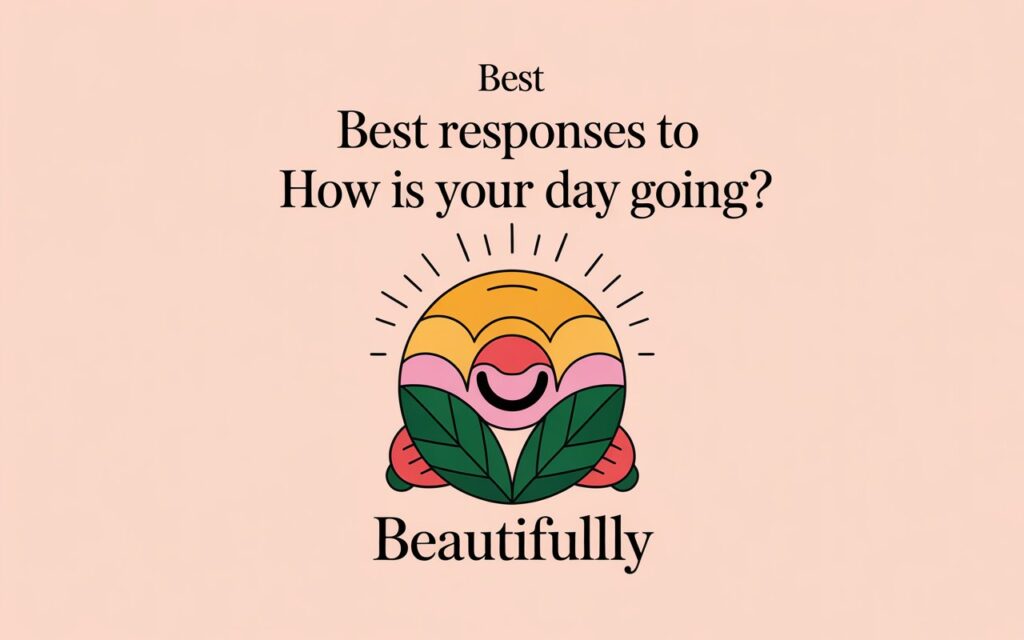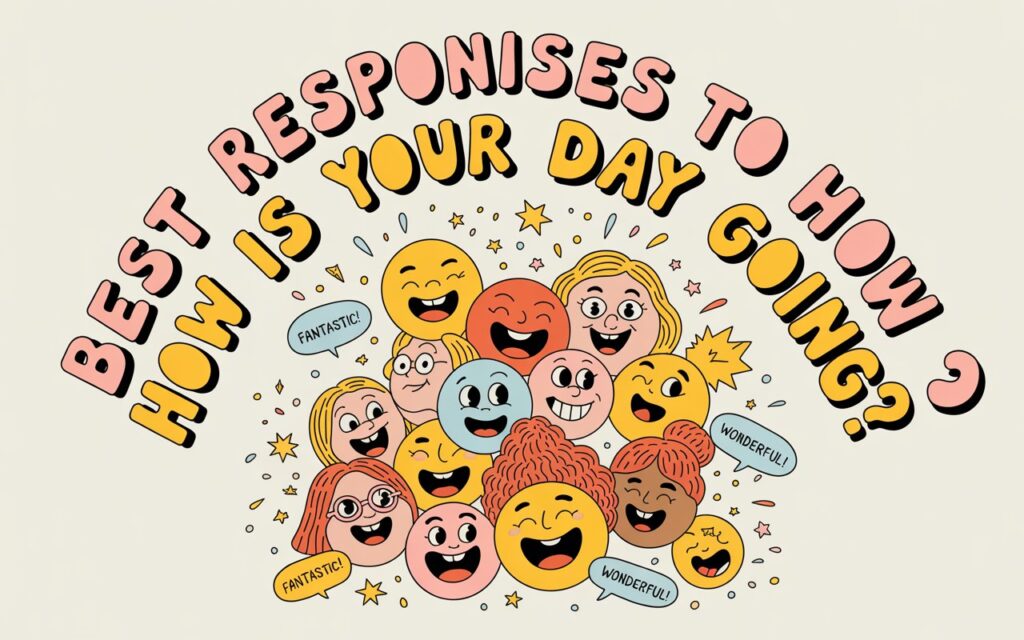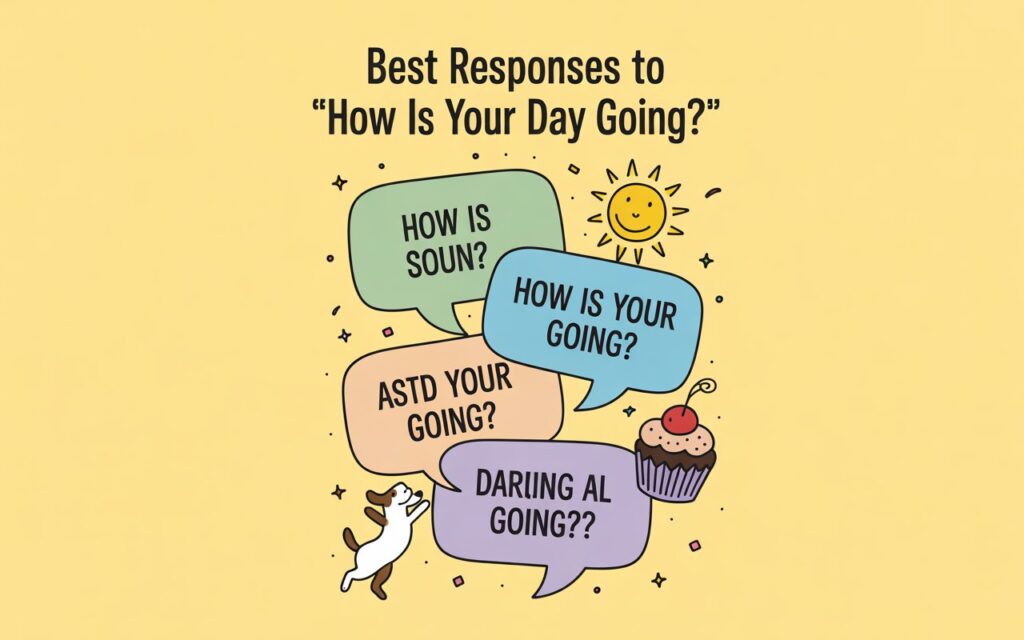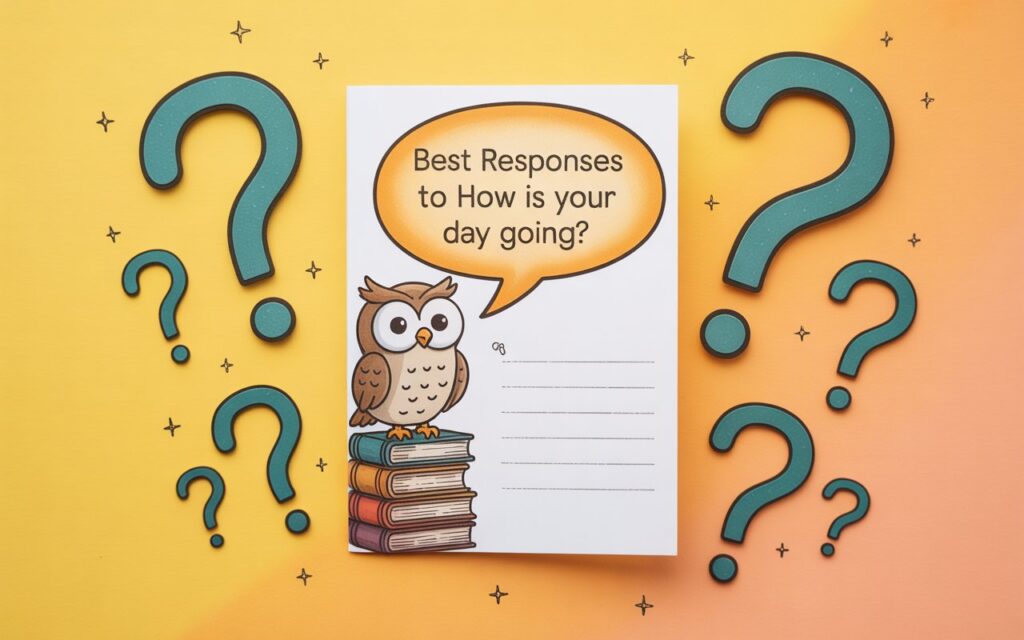Best Responses to “How is Your Day Going?”
When someone asks, “How is your day going?”, they aren’t just making small talk; they are opening a door to connection. In the USA, this phrase is one of the most common casual greetings used in both friendly and professional settings. Knowing the best responses to greetings can help you show confidence, warmth, or even humor depending on the situation. Whether you need short responses for small talk at work, a lighthearted comeback with friends, or a more thoughtful answer to a loved one, your choice of words matters. Great replies turn routine social interactions into opportunities for deeper conversations.
Every day in the United States, people exchange casual greetings like “How is Your Day Going?” without always expecting a detailed answer. It is one of the most common conversation starters in both formal and informal settings. While it may sound like small talk, the way you answer can show your mood, your conversational skills, and even your personality. The truth is that the question is more than just routine. It gives you a chance to connect, to show empathy, or to use humor. Learning different How is Your Day Going responses is not only about being polite, but also about understanding social interactions and improving your ability to hold meaningful conversations in everyday life.

220+ Best Responses to “How is Your Day Going?”
There are countless polite responses you can use depending on your mood and situation. In this section, we divide them into different styles such as positive replies to How is Your Day Going, enthusiastic responses, funny ways to respond, tired and drained replies, or even flirty and friendly replies. For example, if you are in a good mood, you might say, “It’s been great so far, thanks for asking.” If you are busy, you could say, “It’s going fast, lots to do today.” And if you want to be humorous, you could try, “It’s going like a Netflix series—some drama, some comedy, and a lot of suspense.”
The best way to use these replies is to adjust them to the person asking. With friends, you may prefer funny replies for friends, while in the office you need professional responses to colleagues. Below is a simple table that shows how different replies work in different settings.
| Situation | Example Response | Tone |
| Workplace small talk | “It’s going smoothly, thanks. How about you?” | Professional |
| Casual chat with friends | “Pretty good, but better now that we’re talking.” | Friendly |
| Busy day responses | “It’s hectic, but I’m hanging in there.” | Neutral |
| Flirty conversation | “Better now that you asked.” | Playful |
| Stressed out responses | “Honestly, it’s been rough, but I’ll survive.” | Emotional |
Why Do People Ask “How is Your Day Going?”
In the USA, everyday greetings in English are not always about seeking deep truth. Many people use this phrase as part of phatic communication, which means words used mainly to start social interactions. It is less about the answer and more about showing kindness, presence, and politeness. When a cashier asks you, “How is Your Day Going?” they may not expect your full life story. Instead, it is a form of conversation etiquette that makes both sides feel acknowledged.
At the same time, close friends or family may ask the same question with a genuine desire to hear an emotional response. This is why understanding cultural communication norms is important. The same words can either be a quick hello or an invitation to share. Recognizing the difference will help you give more thoughtful answers and avoid awkwardness.

The Psychology Behind the Question
Psychologists explain that How is Your Day Going responses work as a type of bonding tool. Humans rely on small talk examples to reduce social distance and build comfort. Asking about someone’s day is not just about routine; it is about emotional connection. Researchers call this “phatic communication,” where the goal is to create social warmth rather than exchange information.
When you answer, you are actually giving the other person a chance to feel acknowledged. Using grateful and appreciative replies can even lift someone’s mood. For example, saying, “Thanks for asking, I really appreciate it,” not only shows polite conversation etiquette but also builds trust. In a way, your reply becomes a mirror of your relationship with that person.
Common Casual Responses to “How is Your Day Going?”
In casual settings, people expect short and lighthearted general responses. These can be short responses for small talk, quick neutral replies, or even chill answers if you don’t feel like talking much. For example, many Americans simply say, “Good, how about you?” because it keeps the flow of the conversation easy.
Some people add a little more detail to make the interaction warmer. Saying, “It’s been busy but good, thanks for asking,” is an example of a thoughtful answer that still feels simple. The goal of casual exchanges is not to overwhelm the listener but to keep the conversational skills smooth and friendly.

Formal and Professional Replies for Work or Business
When it comes to workplace communication, your replies should remain polished. For professional responses to colleagues, it is better to keep it neutral and polite. A good example would be, “It’s going well, thank you. How about you?” These kinds of polite responses show professionalism while still sounding approachable.
If you are speaking with a client, boss, or during workplace small talk, avoid sarcastic responses or too many personal details. Instead, use polite and engaging responses that make you appear focused. For example, you could say, “It’s been productive, I’m glad we’re making progress on the project.” Such replies create a positive impression and strengthen building connections in a professional setting.
Funny and Witty Responses to Lighten the Mood
Sometimes the best way to stand out is by using funny ways to respond. Humor works especially well in casual social interactions or when chatting with friends. For example, you might say, “It’s going well, but my coffee hasn’t kicked in yet.” Or, “It’s like a roller coaster—fast, loud, and I’m just holding on.”
Using humor also works as a conversational icebreaker. Many people find funny replies for friends more memorable than standard answers. Just be careful not to use humor in a serious work meeting or during sensitive moments. A balance of casual greetings and humor can make your personality shine without crossing boundaries.

Short and Simple Replies When You’re Busy
There are moments when you simply don’t have time for long replies. In those cases, short polite answers for strangers or colleagues are enough. Saying, “Good, thanks,” or “All good, just busy,” communicates respect without being rude. These short responses for small talk keep the conversation flowing even if you’re in a rush.
Another way to save time is to return the question immediately. For example, “Busy but fine. How about you?” This shows that you still value conversation etiquette while staying efficient. Using busy day responses like this is especially useful in work emails or quick chats in the hallway.
How to Respond Based on Context and Body Language
Not every situation calls for the same reply. Paying attention to context and body language is key in responding naturally. If someone asks you while smiling warmly, they may be looking for engaging replies to how are you. If their tone is neutral, a short answer may be enough.
Everyday communication tips often highlight the importance of listening as much as speaking. By noticing whether someone is rushed, stressed, or relaxed, you can shape your response to fit. This is part of mastering best small talk practices and improving your conversational skills.
Cultural Differences in Responding to “How is Your Day Going?”
In the USA, “How is Your Day Going?” is an expected part of everyday greetings in English. In the UK, people may say, “You alright?” while in Australia it may be “How ya going?” In some Asian cultures, however, such personal questions may feel too direct, and instead people use greetings related to meals or health.
Understanding these cultural communication norms is important for travelers. Using casual chat expressions correctly shows respect and helps with building connections abroad. What may seem like small talk in one culture could be seen as sincere concern in another.
Flirty or Friendly Responses to Build Connections
Sometimes people ask about your day not just for small talk but to build closer ties. In dating, using date conversation tips can make a big difference. Saying, “My day was okay, but it’s better now that you texted,” is a flirty reply that shows interest.
In friendships, friendly replies may sound like, “It’s been good, especially since I got to see you.” These hopeful conversation replies add warmth and help with building connections. When used correctly, your answer can move from simple casual greetings to deeper meaningful conversations.
Things You Should Avoid Saying in Response
Not every answer works well. Some emotional responses such as oversharing personal drama or giving sarcastic responses in serious situations can make others uncomfortable. Saying, “My day is terrible, thanks for asking,” may sound too negative for workplace small talk or casual greetings.
It is also best to avoid emotional and vulnerable answers with strangers like cashiers or colleagues you barely know. Save these for close friends. The key is to balance honesty with respect for conversation etiquette.
How to Make Your Reply More Engaging and Memorable
If you want your reply to stand out, you can use thoughtful answers or ask a follow-up question. For example, “It’s been busy, but exciting. How about yours?” This turns the small talk into icebreaker questions and answers that encourage meaningful conversations.
Another way is to share a mini story. For instance, “Pretty good—I tried a new café this morning and loved it.” This shows your personality and creates room for conversational icebreakers. These polite and engaging responses turn routine social interactions into stronger building connections.
Final Thoughts Using “How is Your Day Going?” to Connect Better
At first, answering “How is Your Day Going?” may feel like just another task in everyday communication tips. But when you pay attention to polite conversation etiquette, context, and mood, the same question becomes a chance to connect. Whether you give enthusiastic responses, keep it short with neutral replies, or make someone laugh with funny ways to respond, your choice matters.
In the end, the best How is Your Day Going responses are those that fit the situation and reflect your personality. By practicing best small talk practices, noticing conversation examples, and using genuine emotional responses, you turn a routine greeting into a moment of connection. And that is the true power of social interactions and conversational skills in everyday life.



